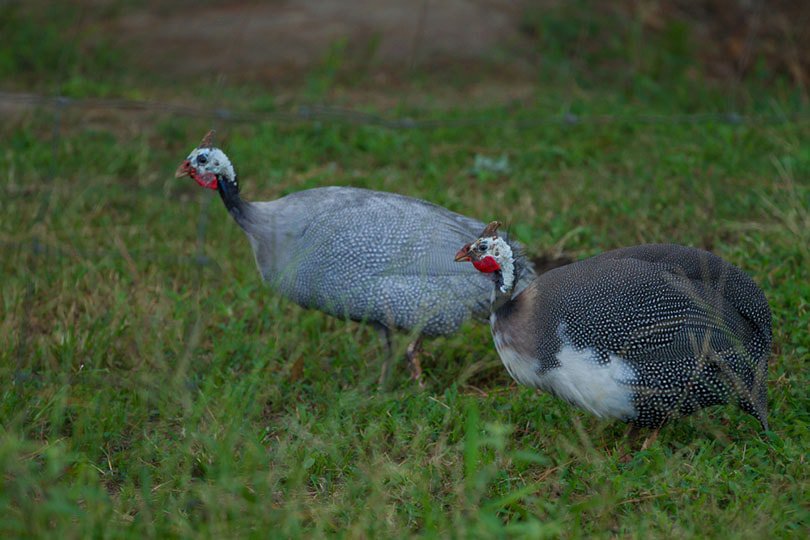Lavender guinea fowl are a variety of guinea fowl, a prized game bird that has since found its place on domestic farms for its “watchdog” qualities and pest control habits. The lavender variety is a unique blue guinea fowl that’s raised for meat and pet purposes.
Guinea fowl are low-maintenance birds and useful additions to a farm for protecting animals from predators and controlling populations of nuisance insects and parasites like ticks.

Quick Facts about Lavender Guinea Fowl
| Breed Name: | Lavender guinea fowl |
| Place of Origin: | West Coast of Africa |
| Uses: | Meat, eggs, pest control |
| Cockerel (Male) Size: | 3.5–4 pounds |
| Hen (Female) Size: | 3.5 pounds |
| Color: | Lavender, blue, gray |
| Lifespan: | 10–15 years |
| Climate Tolerance: | Mild |
| Care Level: | Low maintenance |
| Production: | 60–100 eggs per season |
Lavender Guinea Fowl Origins
Depictions of the guinea fowl have been discovered on buildings from Ancient Egypt and Greece, some as far back as 2400 B.C. Greeks are believed to have raised guinea fowl for meat and egg delicacies. As a wild bird, the guinea fowl is a prized game bird like its pheasant and quail cousins.
The breed is closely related to pheasants and quail and comes from the West Coast of Africa. Guineas are gaining in popularity in the U.S. and found on farms, now outselling pheasants and quails. Many people keep guinea fowl as pets or on hobby farms.
Lavender Guinea Fowl Characteristics
Lavender guinea fowl are social birds that live in flocks. They typically roost together at night. Though the bird can fly, it spends most of its time on the ground. As a farm bird, the guinea fowl is low-maintenance and hardy, perfect for amateur keepers.
Many hobby farms keep guinea fowl to control pest populations – particularly ticks – and warn of predators. Guinea fowl are excellent watchdogs and alert other animals and humans to the presence of threats like foxes, wolves, raccoons, and wildcats.
Uses
As production poultry, guinea fowl offer darker meat than chicken that’s lean and rich in vitamins. In addition to being raised for meat or eggs themselves, guinea fowl are commonly found on hobby farms that use the bird to control pest populations instead of using chemicals or pesticides.
Appearance & Varieties
The lavender guinea fowl is unique in its stunning icy gray chook with bluish coloring, lending its name. Other than coloration, the lavender guinea fowl looks like other guinea fowl with naked heads, a round body, a feathered crest, and voluminous body feathers. It’s typically about two feet tall. Due to the unique coloration, lavender guinea fowl are preferred as pet birds.
- Related Read: Royal Purple Guinea Fowl
Population, Distribution & Habitat
The guinea fowl’s natural habitat is diverse. Different species live in grassland or savanna, while others prefer semiarid regions or heavily forested areas.
All six species of guinea fowl live in Africa, south of the Sahara Desert. Domesticated guinea fowl are found all over the world, however, and thrive in mild climates. Though the bird is not particularly cold-hardy, it can handle small periods in cold climates with adequate shelter and warmth.

Are Lavender Guinea Fowl Good for Small-Scale Farming?
Lavender guinea fowl are raised on commercial farms, but they’re suited to small-scale farming as well. Guinea hens can produce between 60 and 100 eggs seasonally and may be raised for meat. They’re also ideal as pets or for pest-control or guard purposes on small farms.
The lavender guinea fowl is a stunning variety of the popular guinea fowl. Like its pheasant and quail cousins, the guinea fowl is prized for its meat and eggs. Guinea fowl can also be used to control pests like ticks on farms and alerts other animals and humans to the presence of predators.
Featured Image Credit: Andrew Paul Westfall, Shutterstock
